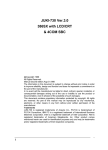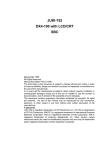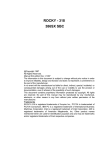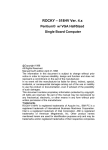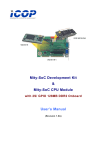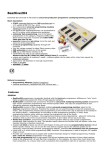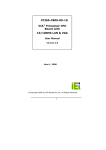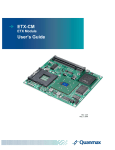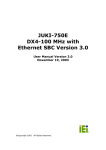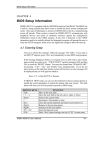Download JUKI-730 User`s Manual V3.1 - IPC2U GmbH
Transcript
JUKI-730 Version 3.0 386SX with LCD/CRT & 4COM SBC User Manual Version 3.1 August 11, 2003 © Copyright 2003 by ICP Electronics Inc. All Rights Reserved. 1 Copyright Notice The information in this document is subject to change without prior notice in order to improve reliability, design and function and does not represent a commitment on the part of the manufacturer. In no event will the manufacturer be liable for direct, indirect, special, incidental, or consequential damages arising out of the use or inability to use the product or documentation, even if advised of the possibility of such damages. This document contains proprietary information protected by copyright. All rights are reserved. No part of this manual may be reproduced by any mechanical, electronic, or other means in any form without prior written permission of the manufacturer. Trademarks JUKI-730 is registered trademarks of ICP Electronics Inc., PC/104 is trademarked of PC/104 Consortium, IBM PC is a registered trademark of International Business Machines Corporation. Intel is a registered trademark of Intel Corporation. AMI is registered trademarks of American Megatrends, Inc. Other product names mentioned herein are used for identification purposes only and may be trademarks and/or registered trademarks of their respective companies. 2 Table of Contents 1. INTRODUCTION ........................................................5 1.1 SPECIFICATIONS .....................................................6 1.2 PACKAGE CONTENTS.................................................8 2. INSTALLATION..........................................................9 2.1 JUKI-730'S LAYOUT ................................................9 2.2 CPU SETTING FOR JUKI-730 VER. 3.0........................ 11 2.3 SYSTEM MEMORY................................................... 11 2.4 WATCH-DOG T IMER ............................................... 12 2.5 DISK ONCHIP™ 2.6 BIOS FLASH CHIP VPP SETTING ................................. 13 2.7 CLEAR CMOS SETUP.............................................. 13 2.8 COM3(CN17) RS232/422/485 SETTING .................... 14 2.9 COM3/COM4 RI PIN SETTING.................................. 15 F LASH DISK .................................... 13 3. CONNECTION .......................................................... 16 3.1 F LOPPY DISK DRIVE CONNECTOR................................. 16 3.2 IDE DISK DRIVE CONNECTOR .................................... 17 3 3.3 PARALLEL PORT..................................................... 18 3.4 SERIAL PORTS ...................................................... 19 3.5 IRDA INFRARED INTERFACE PORT................................ 20 3.6 KEYBOARD /MOUSE CONNECTOR .................................. 21 3.7 EXTERNAL SWITCHES AND INDICATORS .......................... 21 3.8 EXTERNAL POWER CONNECTOR ................................... 22 3.9 EXTERNAL SPEAKER................................................ 23 3.10 PC/104 CONNECTION BUS ....................................... 23 3.11 LCD INTERFACE CONNECTOR..................................... 23 4. AMI BIOS SETUP ..................................................... 25 4.1 GETTING START .................................................... 25 4.2 STANDARD CMOS SETUP......................................... 25 4.3 ADVANCED CMOS SETUP ......................................... 26 APPENDIX A. E2 KEY™ FUNCTION............................... 28 APPENDIX B. WATCH- DOG TIMER ................................ 30 APPENDIX C. PANEL SUPPORT LIST ........................... 31 APPENDIX D. HOW TO UPDATE THE BIOS..................... 32 4 1. Introduction Thank you for choosing JUKI-730 386SX with LCD/CRT/4COM Single Board Computer. The JUKI-730 is an ISA with PC/104 form factor board, which comes equipped with ALI 6117 (386SX CPU included) and an advanced high-performance multi- mode I/O, designed for the system manufacturers, integrators, or VARs that want to provide all the performance, reliability, and quality at a reasonable price. An advanced high performance super AT I/O chip Windbond W83877F and SMC FDC37C669 are used in the JUKI-730 board. Both on-chip UARTs are compatible with the NS16C550 and one COM port can be set in RS232, RS422, or RS485. The parallel port and IDE interface are compatible with IBM PC/AT and XT architectures, as well as EPP and ECP. The LCD/CRT controller is TOPRO TP-6508, which can provide both LCD and CRT display at the same time. The LCD interface connector is a 44-pin 2.0mm pitch type. The most outstanding feature in the JUKI-730 is the built-in PC/104 expansion bus. Based on the PC/104 bus, you could easily install over thousands of PC/104 modules manufactured by hundreds of vendors worldwide. Aside from that, the JUKI-730 has an external power connector that allows direct connection to a power supply making it more suitable for your standalone applications. 5 1.1 l l l Specifications System : ü CPU: ALI 6117,includes 386SX CPU ü DMA channels: ü Interrupt levels: 15 ü Real-time clock/calendar: DS12887/BQ3287 or equivalent chip and quartz oscillator, 128B CMOS memory, powered by lithium battery for over 10 years of data retention. 7 Memory : ü RAM memory: 512KB to 32MB, only support single side 16-bit SIMM. ü Shadow RAM Memory: C0000h ~ DFFFFh ü System BIOS: 0E0000h ~ 0FFFFFh LCD/CRT Interface: ü Chipset: TP-6508 ü Resolution: Support up to 800 x 600 resolution for STN and TFT LCD Flat Panel. And Support 1024x768 256 colors for CRT display. ü Display Memory: 1MB on board. 6 l Input/Output: ü IDE hard disk drive interface: Supports up to two IDE hard disk drives. Can be disabled through BIOS Setup Menu setting. ü Floppy disk drive interface: Supports two 2.88 MB, 1.44MB, 1.2MB, 720KB, or 360KB floppy disk drives. Can be disabled through BIOS Setup Menu setting. ü Two high speed Series ports: NS16C550 compatible UARTs with send/receive 16-byte FIFOs, data rates are independently programmable from 115.2K baud down to 50 baud. The modem controls the circuitry. ü Multi-mode Parallel Port: Standard mode - IBM PC/XT, PC/AT, PS/2 compatible bi-directional parallel port. Enhanced mode - Enhanced parallel port (EPP) compatible with IEEE 1284 specification. High speed mode - Microsoft and Hewlett Packard extended capabilities port (ECP), compatible with IEEE 1248 specification. l Industrial features : ü Watch-dog timer: Can be set to 1,2,10,20,110,or 220 seconds per period. Reset or NMI was generated when CPU did not periodically trigger the timer. Your program use hex 043 and 443 to control the watch-dog and generate a system reset. ü PC/104 expansion bus: A 64-pin and 40-pin, industrial embedded-PC bus standard. ü External power connector: 8-pin male connector ( Molex 6410 series compatible) 7 ü l 1.2 Keyboard connector: A 5-pin header on board and 6-pin mini-DIN keyboard connector is located on the mounting bracket. General : ü Power Consumption: +5V @ 1.53A ( 40MHz,8MB RAM) ü Operating Temperature: 0 ° ~ 55° C ü Humidity : 5% ~ 95%, non-condense ü Dimension: 180mm(W) x 122mm(L), standard AT form factor. Package Contents In addition to this User's Manual, the JUKI-730 package includes the following items: • One JUKI-730 386SX with LCD/CRT/4COM Single Board Computer • One RS-232/Printer Cable & RS-232 x 2 Cable • One FDD/HDD Cable 8 2. Installation This chapter describes how to install the JUKI-730. First, the layout of JUKI-730 is shown, and then the unpacking information that you should be careful with is described. After that comes the setting for jumpers and switches for the JUKI-730's configuration, with information such as CPU type selection, system clock setting, and interrupt IRQ setting for serial ports and parallel port and other such settings. 2.1 JUKI-730's Layout <Please turn to the next page> 9 10 2.2 CPU Setting for JUKI-730 Ver. 3.0 • CPU SPEED SETTING: The system clock is generated by the AV9155C-02, and different CPU clock frequency can be selected through JP3 setting in the manner shown in the following table: JP3 8MHz 16Mhz 20MHz 25MHz 40MHz 2.3 1-2 OPEN CLOSE OPEN CLOSE CLOSE 3-4 CLOSE OPEN OPEN CLOSE OPEN 5-6 CLOSE CLOSE CLOSE OPEN OPEN System Memory The system DRAM on board is divided into two banks, bank 0 and 1. Bank 0 is the on board optional 2/4MB DRAM. Bank 1 is a 72-pin SIMM. Based on the chipset function the 72-pin SIMM only supports single side DRAM. There are two jumpers related to this setting. • JP1/JP2 : 2/4MB DRAM and 72-pin SIMM selection Function On Board 2/4MB 72-pin SIMM JP1 CLOSE OPEN 11 JP2 CLOSE OPEN 2.4 Watch-Dog T imer The Watch-Dog Timer is enabled through reading port 443H. It should be triggered before time -out period ends, otherwise it will assume that program operation is abnormal and will issue a reset signal to start again, or activate NMI to CPU. The Watch-Dog Timer can be disabled through reading port 043H. The Watch-Dog Timer time-out period can be set 1,2,10,20,110 or 220 sec. using jumper JP16. • JP18 : Watch-Dog Active Type Setting JP18 2-3 1-2 OPEN DESCRIPTION RESET WHEN WDT TIME-OUT ACTIVATE NMI TO CPU WHEN WDT TIME-OUT DISABLE WDT • JP16 : WDT TIME-OUT PERIOD JP16 1sec 2sec 10sec 20sec 110sec 220sec 1-2 OPEN OPEN OPEN OPEN CLOSE CLOSE 3-4 OPEN OPEN CLOSE CLOSE OPEN OPEN 12 5-6 CLOSE CLOSE OPEN OPEN OPEN OPEN 7-8 OPEN CLOSE OPEN CLOSE OPEN CLOSE 2.5 DiskOnChip™ Flash Disk The DiskOnChip™ Flash Disk Chip (DOC) is produced by M-Systems. The DOC (MD-2200-xMB) is 32-pin DIP package. As DOC is 100% compatible to hard disk and DOS, users don‘t need to install any extra software utility. “Plug and play” function is not only easy to use but also reliable. Currently, DOC is available from 2MB to 72MB in capacity. • JP19 : DiskOnChip™ Memory Address Setting Address CE000 D6000 DE000 1-2 CLOSE OPEN OPEN 3-4 OPEN CLOSE OPEN 5-6 OPEN OPEN CLOSE 2.6 BIOS Flash Chip Vpp Setting There are two types of Flash chips that can be installed unto this board, one is 5V Vpp and the other is 12V Vpp. The Vpp is provided to undergo programming functions. Function 5V Vpp 12V Vpp JP24 2-3 1-2 2.7 Clear CMOS Setup If you want to clear CMOS Setup (for example you forgot the password then you should clear the setting and then reset the password), you should close JP13 for about 3 seconds, then reopen it. To set back to normal operation mode please take 13 off the jumper. If the RTC Chip is Dallas DS12B887 then you should finish this procedure while the board is in power on mode. • JP13 : Clear CMOS Setup (Reserve Function) JP13 OPEN CLOSE DESCRIPTION Normal Operation Clear CMOS Setup 2.8 COM3(CN17) RS232/422/485 Setting COM3 can be set in RS232 or RS422/ RS485 interface using Jumper JP20/JP23. If you select RS422/485 then you need to reset JP21 for RS422 or RS485. • JP23 : COM3 RS-232 or RS-422/485 setting Description RS-232 RS-422 or RS-485 JP23 1-9 close 3-10 close 5-11 close 7-12 close JP20 2-3 1-2 3-4 5-6 7-8 1-2 close close close close • JP21 : COM3 RS-422 or RS-485 setting JP21 2-3 1-2 DESCRIPTION RS-422 RS-485 14 2.9 COM3/COM4 RI Pin Setting COM3 and COM4 can supply +5V or +12V power to the serial devices via RI pin (Pin 9) of the COM port connector. The maximum current provided is 1A with fuse protection for total of two connectors’ 5V/12V outputs. • JP9/JP29 : COM3(CN17),Pin 9 RI signal or 5V/12V output selection Function RI Signal 5V 12V • JP8/JP10 : JP9 2-3 1-2 1-2 JP29 1-2 1-2 2-3 COM4(CN14),Pin 9 RI signal or 5V/12V output selection Function RI Signal 5V 12V JP8 2-3 1-2 1-2 15 JP10 1-2 1-2 2-3 3. Connection This chapter describes how to connect peripherals, switches and indicators to the JUKI-730 board. You can access most of the connectors from the top of the board while it is installed inside the chassis. 3.1 Floppy Disk Drive Connector JUKI-730 board comes equipped with a 34-pin daisy-chain driver connector cable. The detailed pin assignment of the connector is specified as following table: • CN5 : FDC CONNECTOR PIN NO. DESCRIPTION PIN NO. DESCRIPTION 1 GROUND 2 REDUCE WRITE CURRENT# 3 GROUND 4 N/C 5 GROUND 6 N/C 7 GROUND 8 INDEX# 9 GROUND 10 MOTOR ENABLE A# 11 GROUND 12 DRIVE SELECT B# 13 GROUND 14 DRIVE SELECT A# 15 GROUND 16 MOTOR ENABLE B# 17 GROUND 18 DIRECTION# 19 GROUND 20 STEP# 21 GROUND 22 WRITE DATA# 23 GROUND 24 WRITE GATE# 25 GROUND 26 TRACK 0# 27 GROUND 28 WRITE PROTECT# 29 GROUND 30 READ DATA# 31 GROUND 32 SIDE 1 SELECT# 33 GROUND 34 DISK CHANGE# 16 3.2 IDE Disk Drive Connector You can attach two IDE (Integrated Device Electronics) hard disk drives to the JUKI-730 internal controller. The board comes equipped with a 40-pin flat -cable connector. The detailed pin assignment of the connector is specified as following table: • CN4: IDE Interface Connector PIN NO. DESCRIPTION PIN NO. DESCRIPTION 1 RESET# 2 GROUND 3 DATA 7 4 DATA 8 5 DATA 6 6 DATA 9 7 DATA 5 8 DATA 10 9 DATA 4 10 DATA 11 11 DATA 3 12 DATA 12 13 DATA 2 14 DATA 13 15 DATA 1 16 DATA 14 17 DATA 0 18 DATA 15 19 GROUND 20 N/C 21 N/C 22 GROUND 23 IOW# 24 GROUND 25 IOR# 26 GROUND 27 N/C 28 BALE - DEFAULT 29 N/C 30 GROUND - DEFAULT 31 INTERRUPT 32 IOCS16#-DEFAULT 33 SA1 34 N/C 35 SA0 36 SA2 37 HDC CS0# 38 HDC CS1# 39 HDD ACTIVE# 40 GROUND 17 3.3 Parallel Port This port is usually connected to a printer. The JUKI-730 includes an on-board parallel port, which is accessed through a 26-pin flat-cable connector CN12. The detailed pin assignment of the connector is specified in the following table: • CN12 : Parallel Port Connector PIN NO. DESCRIPTION PIN NO. DESCRIPTION 1 STROBE# 2 DATA 0 3 DATA 1 4 DATA 2 5 DATA 3 6 DATA 4 7 DATA 5 8 DATA 6 9 DATA 7 10 ACKNOWLEDGE 11 BUSY 12 PAPER EMPTY 13 PRINTER SELECT 14 AUTO FORM FEED # 15 ERROR# 16 INITIALIZE 17 PRINTER SELECT LN# 18 GROUND 19 GROUND 20 GROUND 21 GROUND 22 GROUND 23 IOW# 24 GROUND 25 GROUND 18 3.4 Serial Ports The JUKI-730 offers two high speed NS16C550 compatible UARTs with Read/Receive 16 byte FIFO serial ports. These ports let you connect to serial devices or a communication network. One DB-9 connector and thee 10-pin headers are provides by the JUKI-730. The detailed pin assignment of the connectors are specified as following tables: • COM1(CN1) : Serial Port Connector PIN NO. 1 DESCRIPTION DATA CARRIER DETECT (DCD) 2 RECEIVE DATA (RXD) 3 TRANSMIT DATA (TXD) 4 DATA TERMINAL READY (DTR) 5 6 GROUND DATA SET READY (GND) (DSR) 7 REQUEST TO SEND (RTS) 8 CLEAR TO SEND (CTS) 9 RING INDICATOR (RI) • COM2(CN21) : 2x5-pin Header at RS-232 mode PIN NO. DESCRIPTION PIN NO. DESCRIPTION 1 DCD 6 DSR 2 RXD 7 RTS 3 TXD 8 CTS 4 DTR 9 RI 5 GND 10 N/C 19 • COM3(CN17) : 2x5-pin Header at RS-422/485 mode PIN NO. DESCRIPTION PIN NO. DESCRIPTION 1 TX- 6 RX+ 2 TX+ 7 RX- 3 8 4 9 5 10 • COM3 (CN17) and COM4(CN14) : 2x5-pin Header PIN NO. 3.5 DESCRIPTION PIN NO. DESCRIPTION 1 DCD 6 DSR 2 RXD 7 RTS 3 TXD 8 CTS 4 DTR 9 RI or 5V/12V 5 GND 10 N/C IrDA Infrared Interface Port The JUKI-730 built-in IrDA port which support Serial Infrared (IR) or Amplitude Shift Keyed IR(ASKIR) interface. When you need to use the IrDA port, you will have to configure SIR or ASKIR model in the BIOS’s COM2 setup. Then the normal RS-232 COM2 will be disabled. • CN6 : IrDA Connector PIN NO. DESCRIPTION 1 5V 2 N/C 3 IR-RX 4 GND 5 IR-TX 20 3.6 Keyboard/Mouse Connector The JUKI-730 provides two keyboard connectors. A 5-pin header connector CN18 supports passive backplane applications. Another one is a 6-pin Mini-DIN connector CN19 on the board mounting bracket for single board computer applications. • CN18 : 5-pin Header Keyboard Connector PIN NO. DESCRIPTION 1 KEYBOARD CLOCK 2 KEYBOARD DATA 3 N/C 4 GROUND 5 +5V • CN19/16 : 6-pin Mini- DIN Keyboard/Mouse Connector PIN NO. DESCRIPTION 1 KEYBOARD DATA 2 N/C 3 GROUND 4 +5V 5 KEYBOARD CLOCK 6 N/C MOUSE DATA N/C GROUND +5V MOUSE CLOCK N/C 3.7 External Switches and Indicators There are many external switches and indicators for monitoring and controlling your CPU board. These features are completely optional so please install them if you need them. The detailed pin assignment of the connectors is specified in the following table: 21 • CN7 : RESET BUTTON PIN NO. DESCRIPTION 1 EXTERNAL RESET 2 GROUND • CN11 : IDE LED connector PIN-NO DESCRIPTION 1 +5V 2 HDD ACTIVE# • CN8 : POWER LED & KEYLOCK PIN NO. 3.8 DESCRIPTION 1 POWER LED ANODE 2 KEY 3 GROUND 4 KEYLOCK 5 GROUND External Power Connector The JUKI-730 has an on-board external power connector CN13. You can connect power directly to the CPU board for some single-board-computer (without passive backplane) application. • CN13 : EXTERNAL POWER CONNECTOR PIN NO. DESCRIPTION 1 +5V 2 +12V 3 -12V 4 GROUND 5 GROUND 22 6 -5V 7 +12V 8 +5V 3.9 External Speaker The JUKI-730 has its own buzzer, you can also connect an external speaker through the connector CN3.: • CN3 : SPEAKER PIN NO. DESCRIPTION 1 GROUND 2 SPEAKER SIGNAL 3.10 PC/104 Connection Bus The JUKI-730's PC/104 expansion bus allows you to attach any kind of PC/104 modules onto it. The PC/104 bus has already become the industrial embedded PC bus standard, so you could easily install over thousands of PC/104 modules coming from hundreds of venders worldwide. NOTE: JUKI-730 allows direct plug in of PC/104 modules so don‘t need to use the PC/104 Connection Kit. 3.11 LCD Interface Connector The JUKI-730 provides a 2x22-pin connector suitable for LCD flat panel interfaces. 23 • CN20: LCD Interface Connector PIN NO. DESCRIPTION PIN NO. DESCRIPTION 1 +12V 2 +12V 3 GND 4 GND 5 +5V 6 +5V 7 FPVEE 8 GND 9 P0 10 P1 11 P2 12 P3 13 P4 14 P5 15 P6 16 P7 17 P8 18 P9 19 P10 20 P11 21 P12 22 P13 23 P14 24 P15 25 P16 26 P17 27 P18 28 P19 29 P20 30 P21 31 P22 32 P23 33 GND 34 GND 35 SHFCLK 36 FLM 37 M 38 LP 39 GND 40 ENABLK 41 GND 42 N/C 43 FPVDD 44 5V 24 4. AMI BIOS Setup The JUKI-730 use AMI BIOS for system configuration, and the AMI BIOS setup program is designed to provide maximum flexibility in configuring the system by offering various options which may be selected to fit end-users’ individual demands. This chapter is written to demonstrate how you can use these features properly. 4.1 Getting Start When the system is powered on, the BIOS will enter the Power-On-Self-Test routines. These routines will be executed for System Test, Initialization and System Configuration Verification. After the POST routines are completed, the following message appears: " Hit < Del>, if you want to run SETUP" To access AMI BIOS Setup program, press <Del> key. 4.2 Standard CMOS Setup Standard CMOS Setup is the first option on the main menu. The standard CMOS setup utility is used to configure the following features: •Date/Time •Hard Disk Type •Floppy Disk Type All of these features are very commonly seen so we here do not describe in detail. 25 4.3 Advanced CMOS Setup After you enter the Advanced CMOS Setup you will see that this Setup program is equipped with a series of help screens, accessed through pressing <F1> key, which will display the options available for a particular configuration features. All the items on the left side of the screen are very common so they will not be mentioned within this manual. Here, we will focus on some special items that are only found in JUKI-730. These items are specified below: •On-board IDE Controller : The IDE hard disk drive can be Enable or Disable through this item. When you do not need the hard disk, the IDE controller can be disabled. •On-board Floppy Controller : The floppy disk drive can be Enable or Disable through this item. When you do not need floppy disk, the FDD controller can be disabled. •Serial Port 1 : The options are Disable, 3E8,2F8 , or 3F8. You can either set the I/O address of the serial port (COMA) or disable it. •Serial Port 2 : The options are Disable, 2E8,3F8,or 2F8. You can either set the I/O address of the serial port 1 (COMB) or disable it. •Parallel Port : The options are Disable, 3BC, 378 or 278. You can either set the I/O address of the parallel port or disable it. •Parallel Port Mode : JUKI-730 provides EPP,ECP,ECP+EPP, and Normal Mode. •Primary Display : You could set VGA/EGA, CGA40x25, CGA80x25, Mono or Absent. When configured to Absent, JUKI-730 will not check the display adapter while powering on the system. 26 •System Keyboard : You could set Present or Absent. When set Absent, JUKI-730 board will not check the display adapter while powering on the system. 27 Appendix A. E2 Key™ Function The JUKI-730 provides an outstanding E2KEY™ function for system integrator. Based on the E2KEY™ you could free to store the ID Code, Pass Word, or Critical Data in the 1Kbit EEPROM. Because the EEPROM is a nonvolatile memory, you don’t have to worry about losing very important data. 2 Basically the E KEY™ is based on a 1Kbit EEPROM, which is configured to 64 words (from 0 to 63). You could access (read or write) each word anytime. 2 When you need to use E KEY™ please find the utility enclosed in the package. The software utility will include the following four files README.DOC E2KEY.OBJ EKEYDEMO.C EKEYDEMO.EXE. E2KEY.OBJ provides two library function for user to integrate their 2 application using E KEY™ function. These libraries (read_e2key and write_e2key) are written and compiled in C format. For easy implementation, please refer to the following statements. unsigned int read_e2key(unsigned int address) 2 /* This function will return the E KEY™ ’s data at address. The address range is from 0 to 63. Return data is one word, 16 bits */ void write_e2key(unsigned int address,unsigned data) 2 /* This function will write the given data to E KEY™ at address. The address range is from 0 to 63. The data value is from 0 to 0xffff. */ For easy start, please refer to the included EKEYDEMO.C code first. 28 Please note the E2KEY™ function is based on the working of parallel port. So you should enable the JUKI-730’s parallel port, otherwise will not be working. 29 Appendix B. Watch-Dog Timer The Watch-Dog Timer is provided to ensure that standalone systems can always recover from catastrophic conditions that caused the CPU to crash. This condition may have occurred by external EMI or a software bug. When the CPU stops working correctly, hardware on the board will either perform a hardware reset (cold boot) or a non- maskable interrupt (NMI) to bring the system back to a known state. The Watch-Dog Timer is controlled by two I/O ports. 443 (hex) 043 (hex) Read Read Enable the refresh the Watch-Dog Timer. Disable the Watch-Dog Timer. To enable the Watch-Dog Timer, a read from I/O port 443H must be performed. This will enable and activate the countdown timer, which will eventually time out, and either a reset action of the CPU or cause an NMI will occur depending on the setting of JP18. To ensure that this reset condition does not occur, the Watch-Dog Timer must be periodically refreshed by reading the same I/O port 433H. This must be done within the time out period that is selected by jumper JP16. A tolerance of at least 30% must be maintained to avoid unknown routines within the operating system (DOS), such as disk I/O that can be very time consuming. Therefore if the time out period has been set to 10 seconds, the I/O port 443H must be read within 7 seconds. Note: When exiting a program, it is necessary to disable the Watch-Dog Timer, otherwise the system will reset. 30 Appendix C. Panel Support List JUKI-730 supports a wide range flat panels. Different flat panels will need different LCD drive set in the BIOS Setup Menu. The default setting is for Color DSTN flat panel. The available BIOS for different panels are listed below. Please note that all BIOS files already include system BIOS and LCD drive BIOS, so you only need to re-program the BIOS flash chip with the file then power on again. MLCD.ROM – BIOS for MONO DSTN 640x480 For example : HOSIDEN HLM6667 HITACHI LMG5160XUFC CASIO MD650TS00-01 OPTREX DMF_50260NFU-FW-8 DSTN.ROM – BIOS for Color DSTN 640x480 For example : SANYO LCM-5331-22NTK SHARP LM64C35P TFT_S1.ROM – BIOS for TFT 640x480-SYNC (16-bit) TFT_S2.ROM – BIOS for TFT 640x480-SYNC (18/24-bit) For example : HITACHI TX26D60/TX24D55 TOSHIBA LTM09C015A SHARP LQ10D321 TFT_LP1.ROM – BIOS for TFT 640x480-LP(16-bit) TFT_LP2.ROM – BIOS for TFT 640x480-LP(16/24-bit) For example : TOSHIBA LTM09C015A TFT86_S1.ROM – BIOS for TFT 800x600-SYNC(16-bit) TFT86_S2.ROM – BIOS for TFT 800x600-SYNC(18/24-bit) For example : NEC NL8060AC26-05 NEC NL8060AC26-04 NEC NL8060BC31-02 EL.ROM – BIOS for EL 640x480 For example : PLANAR EL640.480-A PLASMA.ROM – BIOS for PLASMA 640x480 For example : PANASONIC S817 31 Appendix D. How to Update the BIOS 1. You can use EPROM Programmer setting to configure the right type of Flash then write the file into the Flash. To apply this method, you should carefully take Flash chip out of socket and then put it back after you finish programming. Most commonly seen flash type is: ATMEL AT29C010A Or, 2. There is also a utility (FLASH634.COM) that can be used to re-program the BIOS directly under DOS environment. For example: C:>FLASH634 MLCD.ROM 32
































